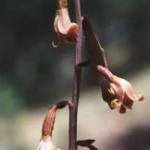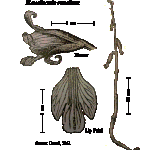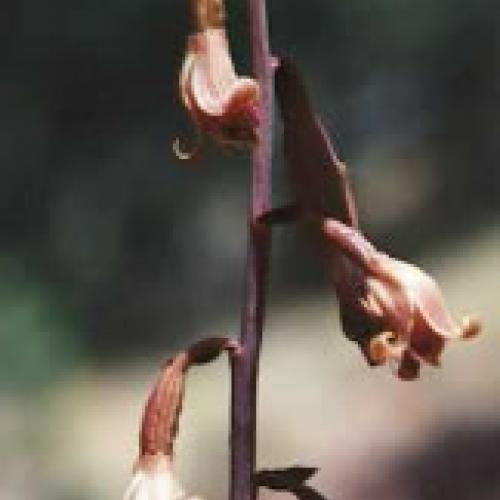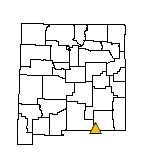Description
Herbaceous saprophytic perennial; stems 40-50 cm tall, pale pink to rose to tan, leafless except for a few widely spaced bracts; inflorescence a raceme with 10-20 rose-tan to whitish flowers; sepals and petals pale rose-tan with light veining, free and spreading, revolute with outer third rolled back 360 degrees or more; dorsal sepal lanceolate, 2.2 cm long, 0.8 cm wide; lateral sepals elliptic lanceolate, oblique, 2.0 cm long, 0.8 cm wide; petals elliptic to obovate, slightly falcate, 0.6 cm long, 1.8 cm wide; lip broadly elliptic, deeply three-lobed, 1.5 cm long, 1.2 cm wide, white to pale rose-tan, with purple veining on lateral lobes and 5 or 7 raised purple ridges running the entire length of the central lobe; column narrow, curved, 1.5 cm high, white with purple shading at the base; anther cap yellow, minute wings near the apex; pollinia yellow, 8 in 4 pairs; capsules pendant, ellipsoidal, 2.0 cm long, 0.5 cm wide. Flowers May through August.
Similar Species
Species of Corallorhiza may be confused with this genus, but the lips in Corallorhiza have no longitudinal ridges (crests) as in Hexalectris. Hexalectris revoluta is the only Hexalectris in New Mexico with sepals and petals rolled back 360 degrees or more. Hexalectris colemanii also has revolute sepals and petals, but it is confined to southeastern Arizona.
Distribution
New Mexico, Eddy County, Guadalupe Mountains; western Texas; Mexico.
Habitat
Under trees and shrubs at the edges of canyon bottoms; in heavy leaf litter under oaks or in thin humus soils among rock outcrops; 1,950 m (6,400 ft) at Eddy County location, 1,250-2,440 m (4,100-8,000 ft) elsewhere.
Conservation Considerations
Populations are small and can be easily obliterated by human activity. Documented records are needed to develop the geographic range of this species in New Mexico, but collections must be made judiciously and without digging the rhizome system.
Important Literature
*Coleman, R.A. 2002. The wild orchids of Arizona and New Mexico. Cornell University Press, Ithaca, New York.
*Correll, D.S. 1941. Studies in Isochilus, Mormodes and Hexalectris. Botanical Museum Leaflets 10(1):18-20.
*Flora of North America Editorial Committee. 2002. Flora of North America, volume 26. Oxford University Press, New York.
Kennedy, A.H. and L.E. Watson. 2010. Species delimitations and phylogenetic relationships within the fully myco-heterotrophic Hexalectris (Orchidaceae). Systematic Botany 35(1):64-76.




